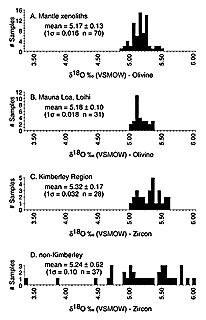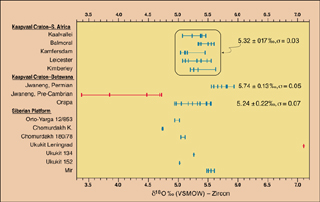Zircon Megacrysts From Kimberlite: Oxygen Isotope Variability Among Mantle Melts
Valley, John W., Kinny, Peter D., Schulze, Daniel J., and Spicuzza, Michael J. (1998) Zircon megacrysts from kimberlite: oxygen isotope variability among mantle melts. Contributions to Mineralogy and Petrology, v. 133, p. 1-11
Abstract
The oxygen isotope ratios of Phanerozoic zircons from kimberlite pipes in the Kaapvaal Craton of southern Africa and the Siberian Platform vary from 4.7 to 5.9‰ VSMOW. High precision, accurate analyses by laser reveal subtle pipe-to-pipe differences not previously suspected. These zircons have distinctive chemical and physical characteristics identifying them as mantle-derived megacrysts similar to zircons found associated with diamond, coesite, MARID xenoliths, Cr-diopside, K-richterite, or Mg-rich ilmenite. Several lines of evidence indicate that these d18O values are unaltered by kimberlite magmas during eruption and represent compositions preserved since crystallization in the mantle, including: U/Pb age, large crystal size, and the slow rate of oxygen exchange in non-metamict zircon. The average d18O of mantle zircons is 5.3‰, ~0.1‰ higher and in equibrium with values for olivine in peridotite xenoliths and oceanic basalts. Zircon megacrysts from within 250 km of Kimberley, South Africa have average d18O = 5.32 ± 0.17‰ (n = 28). Small, but significant, differences among other kimberlite pipes or groups of pipes may indicate isotopically distinct reservoirs in the sub-continental lithosphere or asthenosphere, some of which are anomalous with respect to normal mantle values of 5.3 ± 0.3‰. Precambrian zircons (2.1-2.7 Ga) from Jwaneng, Botswana have the lowest values yet measured in a mantle zircon, d18O = 3.4 to 4.7‰. These zircon megacrysts originally crystallized in mafic or ultramafic rocks either through melting and metasomatism associated with kimberlite magmatism or during metamorphism. The low d18O zircons are best explained by subduction of late Archean ocean crust that exchanged with heated seawater prior to underplating as eclogite and to associated metasomatism of the mantle wedge. Smaller differences among other pipes and districts may result from variable temperatures of equilibration, mafic versus ultramafic hosts, or variable underplating. The narrow range in zircon compositions found in most pipes suggests magmatic homogenization. If this is correct, these zircons document the existence of significant quantities of magma in the sub-continental mantle that was regionally variable in d18O and this information restricts theories about the nature of ancient subduction
| Figure
4. Values of d18O
for mantle-derived zircon megacrysts from kimberlite pipes in southern
Africa and Siberia. The Ukukit Leningrad sample at 7.1‰ is
inherited (see text). |

